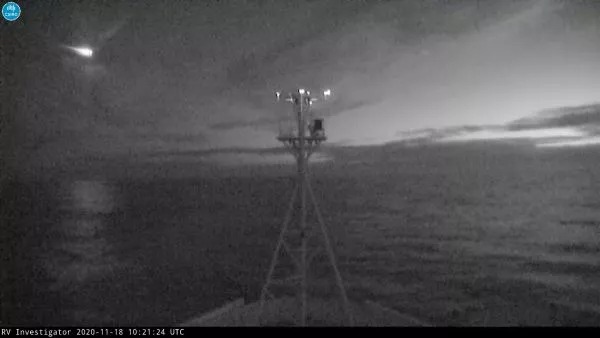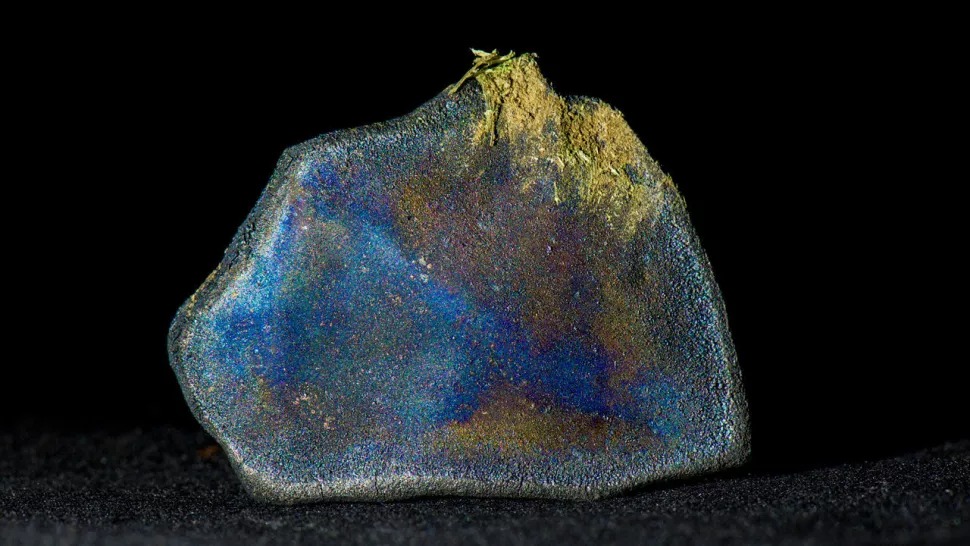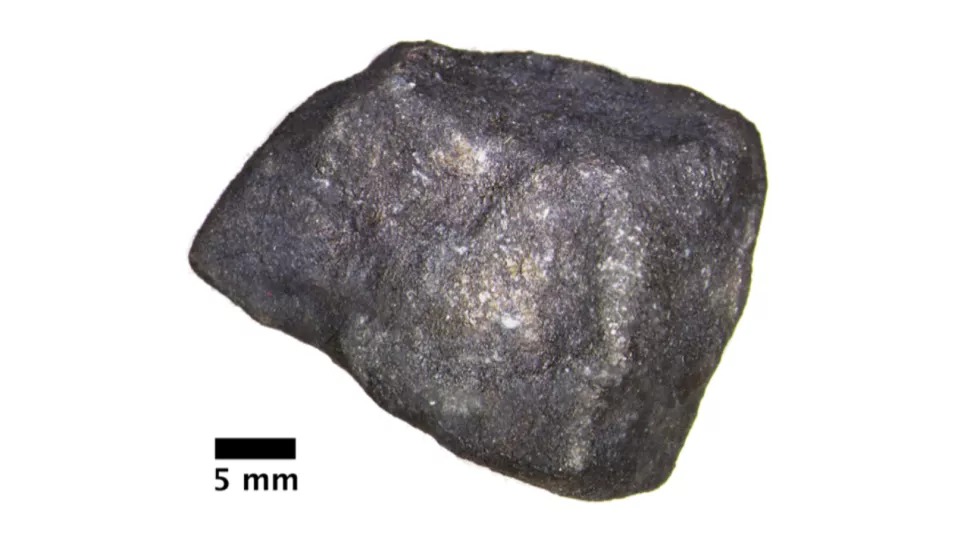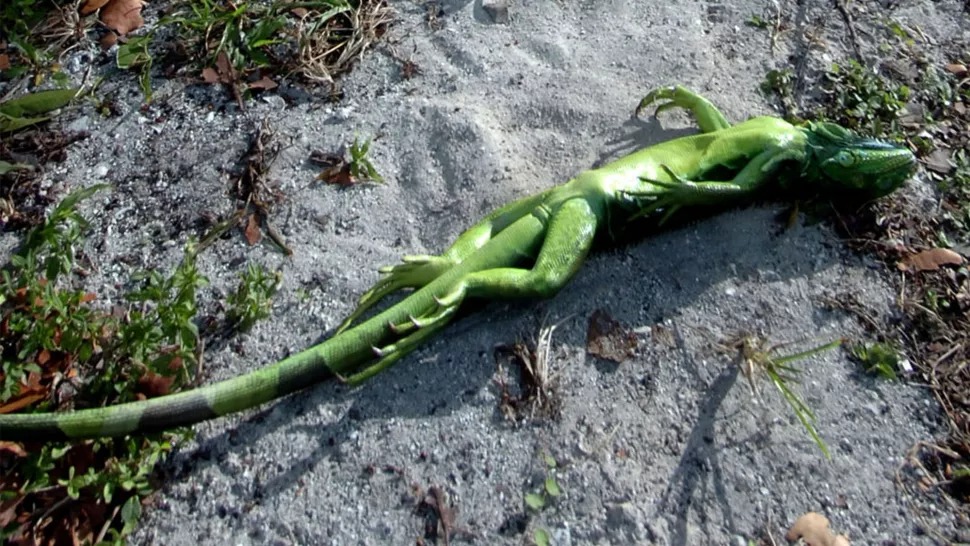Space rocks crash to Earth carrying compounds that were formed billions of years ago. Spaceships perform fancy flips in the air but explode when they touch back down too quickly. And sometimes, iguanas fall from trees and land belly-up, frozen on the ground.
Here's a list of seven intriguing objects - and a few reptiles - that made headlines for falling from the sky.
Exploding, green fireball over the Tasman Sea
 (CSIRO)
(CSIRO)
Researchers captured an incredible video when a bright, green meteor zipped over the southern coast of Tasmania, Australia - though a bit unfortunately, the video is in black-and-white.
A research vessel called Investigator, which is operated by Australia's national science agency, CSIRO, filmed the fireball as it burst through Earth's atmosphere, crossed the sky and then disintegrated above the Tasman Sea.
People who witnessed the meteor first-hand said that it appeared green to the naked eye.
Rainbow meteorite found in Costa Rica
 (Laurence Garvie/Center for Meteorite Studies/Arizona State University)
(Laurence Garvie/Center for Meteorite Studies/Arizona State University)
A rainbow-color space rock broke up over Costa Rica in 2019 and scattered debris between the villages of La Palmera and Aguas Zarcas. Now, ongoing studies hint that the fireball may contain the chemical building blocks of life.
The soft meteor originally broke off of a larger asteroid, which formed out of dust from an ancient nebula. That very nebula would later birth our Solar System. The rainbow meteor contains complex carbon compounds, which may include amino acids, which can come together to form proteins and molecules like DNA.
The sudden explosion of a SpaceX prototype
 (SpaceX)
(SpaceX)
SpaceX's Starship program launched a prototype called SN8 during a high-altitude test flight, and all went according to plan - other than the landing. The prototype took off from SpaceX's facility Boca Chica, Texas and zoomed about 7.8 miles (12.5 kilometers) into the sky, performing complex aerial maneuvers on the way.
The vehicle then descended onto a designated landing mark on the ground, but it came in too fast and burst into flames. The explosion occurred just 6 minutes and 42 seconds after lift off.
A meteorite in Michigan
 (Heck et al., Field Museum)
(Heck et al., Field Museum)
A meteorite crumbled up in the sky over Hamburg, Michigan, and the pieces fell down onto a frozen lake below. That was in January 2018; this year, after thoroughly analysing the space rock, scientists announced that the meteorite contained thousands of organic compounds that formed billions of years ago.
The compounds date back to the early days of our Solar System, meaning meteorites that crashed onto young Earth may have carried similar molecules. Back then, organic compounds from meteors could have been incorporated into primitive microbes, the team said, so studying the Michigan meteor can give us a glimpse into early life on the planet.
Comet debris may have leveled an ancient Syrian village
 (Jennifer Rice/CometResearchGroup.org)
(Jennifer Rice/CometResearchGroup.org)
The prehistoric village of Abu Hureyra in northern Syria housed the first known farmers on Earth, but then some mysterious, fiery incident destroyed the town, leaving mostly remnants of thatched huts coated in carbon.
Among the wreckage, excavators also found glass spheres formed from melting soil, melted iron- and sulfur-rich samples and nanodiamonds.
Scientists recently examined these glassy materials more closely and found that they could only have formed at temperatures over 3,630 F (2,000 C). The team concluded that fragments from a passing comet likely exploded over the village, releasing an intense heatwave that scorched the village and the soil beneath it.
Dinosaur-killing asteroid struck at the worst possible angle
 (Chase Stone)
(Chase Stone)
The monstrous space rock that wiped out the dinosaurs slammed into Earth at such a steep angle that the dinos never really stood a chance. Scientists modeled the path of the asteroid and found that it struck at an angle of about 60 degrees above the horizon.
Compared with shallower impact angles, this trajectory caused the asteroid to spew about three times as much sulfur and carbon dioxide into the atmosphere, according to the model. The gas released by the impact triggered global climate change and killed 75 percent of all life on Earth, including all non-avian dinosaurs.
Iguanas raining down on Floridians
 (Chase Stone)
(Chase Stone)
"Cool temperatures with a chance of falling reptiles" - this is essentially the warning the National Weather Service sends out when the temperature falls below 40 degrees Fahrenheit (4.4 degrees Celsius) in southern Florida.
That's because, when the weather gets cool, the iguanas that usually hang out in the treetops become too old to hold onto branches. As their metabolisms slow down, the lizards go stiff, fall to the ground and appear dead; but once the weather warms up, they snap back into action.
This article was originally published by Live Science. Read the original article here.
#Space | https://sciencespies.com/space/fireballs-and-iguanas-7-weird-things-that-have-fallen-from-the-sky/
No comments:
Post a Comment